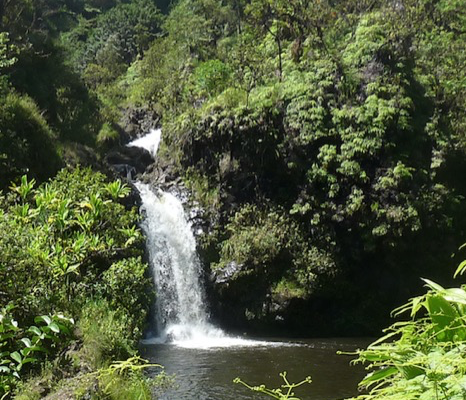Under contract to MEDB, the Millennium Institute created a simulation to aid in decision making for water policy. See Millennium Institute website.
Improving Understanding of Maui’s Water System to Inform Decision-making and Support Policy Formulation and Evaluation
 |
Maui, a place of scenic beauty and exotic cultures, has long been one of the most desirable tourist destinations in the world. But with a rapidly growing population, and an expanding economy, there has been an overall increase in the demand for water. Being the most fundamental aspect of all biological systems, water plays an integral role in every ecological process, and has become a contentious issue on Maui.
Due to a steep geological gradient present on the island, parts of Maui are endowed with abundant amounts of water, whereas other areas suffer from low precipitation and long periods of drought conditions.
To help expand and accommodate the agriculture sector, complex ditch, tunnel and reservoir systems were built on the island over a century ago, which divert water from the eastern, rainy part of the island, to the dry, central area. Today, the diversions have caused many of Maui’s aquifers to become over pumped and are having devastating impacts on the local streams and ecosystems.
The water system on Maui also holds a strong cultural relevance and value to the local population. The practice of cultivating taro, a traditional starch in the indigenous diet, and a culturally significant crop, relies heavily on the availability of fresh, flowing water for optimal growth. Growing taro is an integral element to sustaining Hawaiian culture and holds significant value to its people. As water resources are being diverted from the streams within which this vegetable is grown, less water is available for production, and the taro crops are more susceptible to malnutrition, disease and other ailments.
In an effort to inform decision making on water resources and to plan for sustainable growth on the island, the Maui Economic Development Board (MEDB) entered into a cooperative agreement with MI to improve overall understanding of the water system in Maui and to provide the community with a simulation tool to inform decision making and support policy formulation and evaluation.
By creating an integrated simulation model that captures the social, economic and environmental characteristics of the problem, system-wide impacts of community actions can be analyzed in a comprehensive way and help to develop an understanding of the broader implications of the proposed policies and regulations.
The project employed a customized version of the Primary County Model (PCM) developed by MI. System Dynamics was used as the foundation for the customization of the model, to enable the examination of the complex, dynamic interrelationships between water and other social, economic and environmental sectors.
To promote community participation, a group-modeling session was held with local stakeholders such as farmers, landowners, and other concerned citizens. Through this process, local needs and concerns were explored and included in the model. MI staff, including a summer intern, also met with local farmers in the area to incorporate social values within the modeling process.
Because of the strong cultural tradition, and the vibrant economy that is embedded within it, there needs to be a community dialogue to discuss these policies and arrive at common solutions to help facilitate the transition towards a more sustainable future. PCM-Maui can provide valuable insights to policy makers and local stakeholders, but can also be used as an effective tool to create and facilitate a channel of communication within the community.


